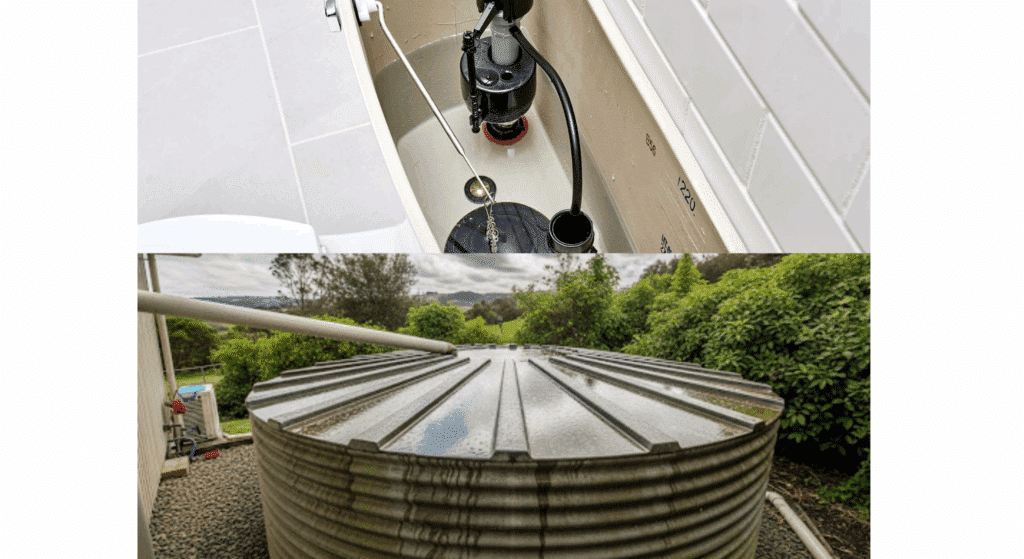Have you ever found yourself in that awkward moment when nature calls, but your water supply has been cut off?
It’s frustrating, especially when you need to use the bathroom and can’t flush properly afterward.
Most people panic or feel embarrassed in this situation. But here’s the thing – you don’t have to wait for the water to come back on. There are several simple methods to flush your toilet even when the water is off.
I’ll show you exactly how to flush a toilet when the water is off using household items you probably already have.
These techniques will save you from uncomfortable situations and keep your bathroom functional during water outages.
Why Water Shutoffs Happen
Water shutoffs can catch you off guard when you least expect them.
Your local water company might turn off the supply for scheduled maintenance work on pipes or water treatment facilities. Sometimes they need to repair broken water mains or replace old infrastructure in your neighborhood.
Emergencies also cause sudden shutoffs. Burst pipes, contamination issues, or severe weather damage can force utilities to cut water immediately.
Construction projects often require temporary shutoffs, too, especially when workers install new pipes or connect systems.
Don’t forget about unpaid bills – water companies will shut off service if payments fall behind.
Natural disasters like earthquakes or floods can damage water systems and stop the flow for days. Even power outages affect water pumps in some areas.
Knowing these common causes helps you prepare better for when water stops flowing to your home.
Understanding Your Toilet’s Mechanics

Your toilet works on a simple gravity system that’s easy to understand.
When you press the flush handle, it lifts a flapper inside the tank. This allows water to rush from the tank into the bowl, creating the flushing action.
Here’s what happens during a normal flush:
- Water flows from the tank through holes under the rim
- The rushing water creates a siphon effect in the bowl
- Waste gets pulled down through the trapway
- The flapper closes, and the tank refills automatically
- Fresh water seals the bowl again
Using a Bucket of Water to Flush a Toilet when The Water Is Off

This is the most common and effective method that works every time. You’ll need about one gallon of water for a complete flush.
Step 1: Fill Your Bucket
Get a large bucket or container and fill it with one gallon of water from any available source. A standard household bucket works perfectly, but you can also use large pots, mixing bowls, or even a clean trash can.
Cold or warm water both work equally well for this flushing method.
Step 2: Position and Pour
Stand close to the toilet bowl and pour the water quickly in one steady stream directly into the bowl.
Aim for the center of the bowl where the drain opening is located, pouring from about waist height. The faster you pour, the better the flushing action will be.
Step 3: Check Results
The waste should flush down immediately if you pour fast enough. If everything flushed properly, the water level should return to normal height in the bowl.
If not, simply repeat with another gallon of water using the same quick-pouring technique.
Other Ways on How to Flush a Toilet when The Water Is Off

When your water gets shut off, you might think your toilet becomes useless.
That’s not true at all. There are several practical methods to keep your toilet working normally.
You don’t have to worry, as you do not need any special tools or expensive equipment. Each technique works by creating the same water flow that happens during a regular flush.
Method 1 – The Tank Refill Method
This technique works great when your toilet tank is empty or partially filled. You’re doing what the water supply usually does automatically. It’s perfect for maintaining normal toilet function during short water outages.
This method lets you use the regular flush handle like nothing happened.
- Step 1: Remove Tank Lid – Carefully lift off the toilet tank lid and set it aside in a safe place.
- Step 2: Add Water – Pour water directly into the tank until it reaches the normal water line marked inside.
- Step 3: Flush Normally – Replace the lid and press the flush handle as you normally would.
Method 2 – Emergency Water Sources
Don’t limit yourself to clean drinking water during emergencies. Your water heater tank contains gallons of usable water. Rainwater works perfectly fine for flushing.
Even water from your swimming pool can help in desperate situations. Just remember that pool water contains chemicals, so don’t use it regularly.
- Step 1: Locate Water Source – Find the nearest alternative water source, like your water heater, stored water, or collected rainwater.
- Step 2: Collect Water – Fill containers with the emergency water, prioritizing non-drinking water for toilet use.
- Step 3: Use Any Method Above – Apply the water using either the bucket method or tank refill technique, depending on your situation.
Preventing Future Plumbing Disruptions
Smart planning can help you avoid toilet troubles when water gets shut off again.
Keep a few gallons of water stored in your garage or basement for emergencies. Old milk jugs or water containers work perfectly for this purpose.
Stay informed about planned water shutoffs in your area. Your water company usually sends notices or posts updates on its website. Sign up for alerts if they offer them.
Consider installing a small water storage tank if you live in an area with frequent outages.
Regular plumbing maintenance also helps prevent unexpected problems.
Check your pipes, fix small leaks quickly, and know where your main water valve is located. Being prepared makes all the difference.
When to Call a Professional Plumber
Sometimes the problem goes beyond just knowing how to flush a toilet when the water is off.
Certain situations require professional help to fix underlying issues that prevent your toilet from working properly.
- Persistent clogs that won’t clear – If multiple flushes with buckets of water don’t work, you likely have a serious blockage that needs professional tools to remove.
- Water backing up into other drains – When toilet water appears in your bathtub or sink, this indicates a main sewer line problem that requires immediate professional attention.
- Strange gurgling sounds from pipes – These noises often signal ventilation issues or partial blockages that can worsen without proper repair.
- Toilet won’t refill after water returns – If your toilet tank doesn’t fill normally once water service resumes, internal parts may need replacement or adjustment.
- Sewage smells coming from the toilet – Bad odors indicate seal problems or sewer gas leaks that pose health risks and need expert diagnosis.
Conclusion
Water outages don’t have to leave you stuck with a non-functional toilet anymore. You now have multiple proven methods to handle these situations with confidence.
From the simple bucket technique to using emergency water sources, these solutions work when you need them most.
Remember that knowing how to flush a toilet when the water is off is just one part of good home preparedness.
Keep some water stored for emergencies and stay informed about planned shutoffs in your area.
What’s your backup plan for the next water outage? Try one of these methods and let us know which works best for your home setup in the comments.








